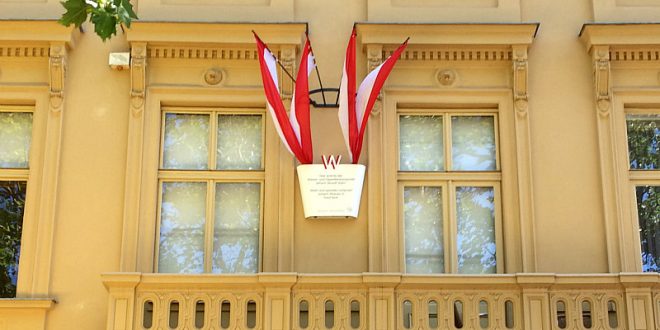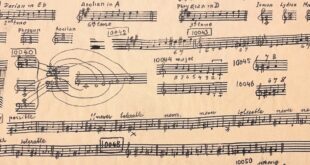Johann Strauss Vienna Guide. Honestly, not even the most fervent Johann Strauss II fans will detect Strauss at every step in Vienna. Too hidden are his former apartments, too secluded exhibitions about him, and too tucked away or irregular are Strauss music events. Hence, here is the top guide to Vienna for fans of the King of Waltz.
Who Was Johann Strauss II?
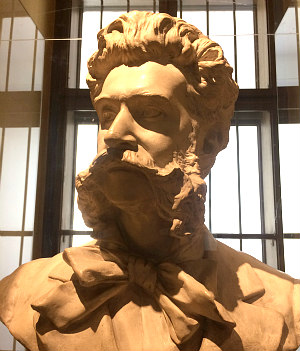 Essentially, Johann Strauss was THE pop music celebrity of 19th century Vienna. The amazing violinist and composer dedicated his life to entertain through dance and music. At times, Strauss is confounded with his musician father Johann Strauss I aka Johann Strauss the Elder. Although father Strauss wrote many popular waltzes, galopps and polkas, it was his son who made the breakthrough as the King of Waltz.
Essentially, Johann Strauss was THE pop music celebrity of 19th century Vienna. The amazing violinist and composer dedicated his life to entertain through dance and music. At times, Strauss is confounded with his musician father Johann Strauss I aka Johann Strauss the Elder. Although father Strauss wrote many popular waltzes, galopps and polkas, it was his son who made the breakthrough as the King of Waltz.
Around 1848, Strauss meteorically rose from suburban dance musician to international star. In the midst of the biggest revolution in Austria’s Empire and its bloody suppression people desperately needed cheering up. Certainly, Strauss’ uplifting waltzes, dynamic polkas and playful quadrilles were a much needed escape for the Empire’s subordinates.
If you love light classical music and ballroom dancing you will likely have Strauss’ signature tunes in your CD collection: from the Blue Danube Waltz (Donauwalzer) and the Emperor’s Waltz (Kaiserwalzer) to the overture from the operetta The Bat (Die Fledermaus).
Johann Strauss Apartment And Other Exhibitions
Basically, the two Strauss museums in Wien are a must for fans keen to understand the waltz king’s universe: One was his former apartment in Leopoldstadt’s Praterstrasse. The other is a privately run museum about the whole Strauss dynasty in Müllnergasse. To give you a flavor let me share some thoughts about them.
Johann Strauss Apartment Praterstrasse
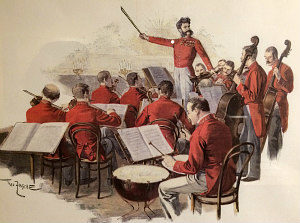
Located on the second floor of a canary-yellow townhouse in a street leading to Prater park, the Strauss apartment exudes old Viennese flair. Leopoldstadt was Strauss’ birth place, and you get a good feeling of his home turf when approaching the apartment.
It was there where Strauss composed the Blue Danube Waltz ‘An der Schönen Blauen Donau’. Given the waltz is played so often to represent classical Austria it has become the unofficial Austrian anthem. The flat itself comprises just a few rooms.
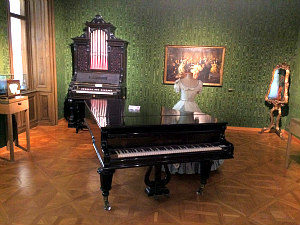
Inside, you will find a charming though modest exhibition of the composer’s life. Two pianos, a period-style Viennese dress and two dozen cute ladies’ ball gifts conjure the world of Vienna’s waltz and operetta star. Although perched in a corner of the main room, Strauss’ original Amati violin represents the exhibition’s highlight. Resting in a vitrine decorated by an elaborately carved frame, the violin embodies Vienna’s golden era.
Throughout the museum, walls and desks showcase drawings, pictures and music posters of Strauss, his family and his most famous works. Sadly, the music stations were also rather modest. During my visit I found out that one of them didn’t work at all. Although the lovely objects on show allowed glimpses into Strauss’ life and work, there was much to be wished for to perfectly tune in to the composer and his music.
Address: Praterstrasse 54, 1020 Vienna
Opening Times: Tuesday to Sunday 10 am to 1 pm and 2 pm to 6 pm (yes, there is a lunch break!)
House of Strauss
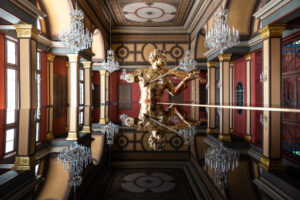 After 186 years Casino Zögernitz, one of Vienna’s old ballrooms and garden establishments, now hosts a contemporary Strauss museum. Collaborating with exhibition planners and experts from the Viennese Institute for Strauss Research (WISF), this immersive exhibition allows you to delve into the narrative of the Strauss dynasty.
After 186 years Casino Zögernitz, one of Vienna’s old ballrooms and garden establishments, now hosts a contemporary Strauss museum. Collaborating with exhibition planners and experts from the Viennese Institute for Strauss Research (WISF), this immersive exhibition allows you to delve into the narrative of the Strauss dynasty.
From an opulent though empty ballroom and resonant concert hall to narratives from that era, the museum delivers an experience that tries to capture the essence of the time.
Although the museum offers interactive operettas and digital music stands my own visit there was a little underwhelming. Do think twice before making the journey out there from the city center.
Address: Döblinger Hauptstrasse 76, 1190 Vienna
Opening Times: Tuesday to Sunday 10 am to 6 pm; public holidays: 10 am to 5 pm.
Museum of the Strauss Dynasty
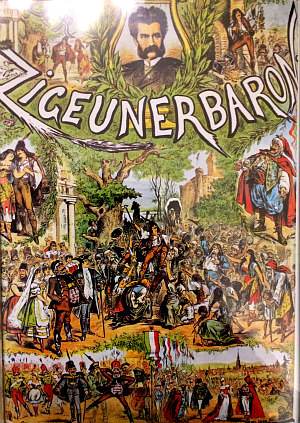 Unlike the Johann Strauss apartment in Praterstrasse the Museum of the Strauss Dynasty focuses on the lives of the composer family: namely Johann Strauss senior, Johann Strauss II, Josef and Eduard Strauss. Although displaying an equally simple exhibition this museum impresses with a clear compelling narrative.
Unlike the Johann Strauss apartment in Praterstrasse the Museum of the Strauss Dynasty focuses on the lives of the composer family: namely Johann Strauss senior, Johann Strauss II, Josef and Eduard Strauss. Although displaying an equally simple exhibition this museum impresses with a clear compelling narrative.
Starting with his musician family, the personality of Johann Strauss II emerges quickly, and interlinks with the different music pieces he composed. For example, this poster of his operetta Zigeunerbaron (‘gipsy baron’) brilliantly expresses the playfulness and dynamics of Strauss’ music. The portrait in the middle shows Johann Strauss himself.
Since Johann’s brothers Josef and Eduard also composed widely recognised music it was helpful to finally learn about their stories and clearly distinguish their musical styles.
What is almost as fascinating about the Strauss clan is their era: Before my visit, Johann Strauss and his music were free floating somewhere in the 19th century. Then at the museum, I not only managed to properly connect him with his family but with the political controversies of Vienna’s Biedermeier era, and with other musicians of his time.
Johann Strauss and Johannes Brahms
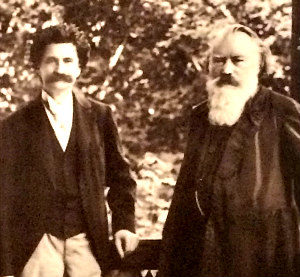
Especially intriguing were the Strauss family members’ different relationships with the Habsburg Emperors. And a photograph of Johann Strauss with his friend, composer Johannes Brahms (photo)! The music stations were similar to the ones at the Strauss apartment, but they worked much better.
When I visited with my private music tour guide Gilles we met Professor Helmut Reichenauer, the driving force behind this private museum. It’s not often the museum’s boss shares his tremendous passion and insight with you (and president of the cultural association ‘Wiener Blut’), so this was a special treat.
Address: Müllnergasse 3, 1090 Vienna
Opening Times: Wednesday to Saturday 2 pm to 6 pm;
Johann Strauss Exhibition At Haus Der Musik
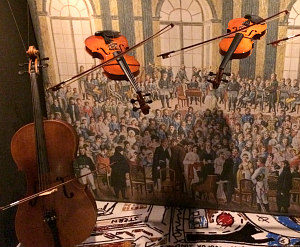 Though it just captured one room I loved the Johann Strauss exhibition at Haus der Musik (House of Music). Generally, the displays told the story of Strauss’ genius rather than fretting about authenticity and context. Enveloped by huge visuals I almost stepped into a group of pending violins. A touch screen not only allowed to pull off vast information about Johann Strauss’ life but also to listen to some of his best compositions.
Though it just captured one room I loved the Johann Strauss exhibition at Haus der Musik (House of Music). Generally, the displays told the story of Strauss’ genius rather than fretting about authenticity and context. Enveloped by huge visuals I almost stepped into a group of pending violins. A touch screen not only allowed to pull off vast information about Johann Strauss’ life but also to listen to some of his best compositions.
If you want to get hands on you can virtually conduct Strauss’ Blue Danube Waltz with the Vienna Philharmonic Orchestra at the House of Music’s fantastic ‘Virtual Conductor’ station. For both adults and children this is big fun and a real must do.
Address: Haus der Musik, Seilerstätte 30, 1010 Vienna
Opening Times: daily, 10 am to 10 pm
Other Sights Related to Strauss
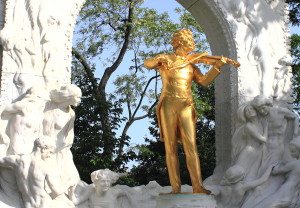 Golden Strauss statue: Vienna’s most eye catching monument is also the most photographed. Right when you enter Stadtpark next to Kursalon a larger than life ‘Schani’ (Strauss’ nickname) beams through the green leafage. Though originally set up in gold in 1921, the statue was black when I was a child six decades later. Only in 1991 did it get its former sparkle back.
Golden Strauss statue: Vienna’s most eye catching monument is also the most photographed. Right when you enter Stadtpark next to Kursalon a larger than life ‘Schani’ (Strauss’ nickname) beams through the green leafage. Though originally set up in gold in 1921, the statue was black when I was a child six decades later. Only in 1991 did it get its former sparkle back.
Collection of Historic Instruments: Do you want to hear the original sound of Johann Strauss? At Vienna’s Collection of Historic Instruments at Neue Burg, start the old phonograph and listen to the Strauss music band play the ‘Fruhlingsstimmenwalzer’ (‘spring voices waltz’).
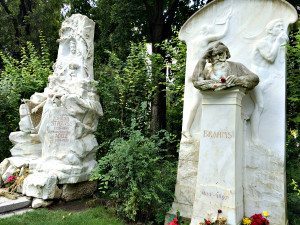 Johann Strauss’ Tomb: One of the most romantic tombstones at the Central Cemetery in Vienna belongs to Johann Strauss and his third wife Adele: A finely chiseled block in white marble displays a nymph with harp, Johann Strauss’ portrait and dancing and fiddling angels.
Johann Strauss’ Tomb: One of the most romantic tombstones at the Central Cemetery in Vienna belongs to Johann Strauss and his third wife Adele: A finely chiseled block in white marble displays a nymph with harp, Johann Strauss’ portrait and dancing and fiddling angels.
Very movingly, Strauss’ final resting place is right next to his dear friend and fellow musician, Johannes Brahms.
Strauss Music Events
Between you and me (and the rest of the internet community) I have a hard time recommending a dedicated Johann Strauss music event that is not touristic. However, quite a few Austrians like to dance to Johann Strauss, see a Strauss operetta or enjoy him on Sunday classical radio together with their breakfast roll. If you book a flight with Austrian Airlines you will most likely listen to the Danube Waltz when you land in Vienna!
However, entire Strauss concerts are mostly left to tourists these days. Probably the most famous exception for listening to top quality Strauss music is the New Year’s Concert.
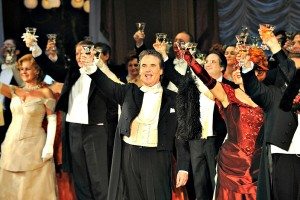 That said, I love Strauss operettas and think they are a perfect opportunity for you to experience Strauss music in a quality authentic setting. My favourite operetta is Die Fledermaus (The Bat). Not only is this musical a hilarious Viennese comedy of errors, but you gain insight into Viennese society of the late Habsburg Empire.
That said, I love Strauss operettas and think they are a perfect opportunity for you to experience Strauss music in a quality authentic setting. My favourite operetta is Die Fledermaus (The Bat). Not only is this musical a hilarious Viennese comedy of errors, but you gain insight into Viennese society of the late Habsburg Empire.
Among the most iconic tunes are the overture and the song ‘Ich lade gern mir Gäste ein’ (‘I like to invite guests’). Fortunately for non-German speakers Volksoper Vienna and Vienna State Opera use English surtitles.
Other fantastic musical theatres by Strauss that sometimes stage in Vienna are Eine Nacht in Venedig (‘A Night In Venice‘) and Der Zigeunerbaron (‘The Gipsy Baron’).
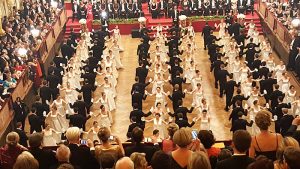 If you like ballroom dancing you will get a guaranteed few Strauss waltzes at a traditional Vienna ball. Most balls stage the famous Fledermaus quadrille at midnight. Following the master of ceremony’s instructions dozens of couples line up opposite each other to synchronise different moves. Usually dancers just imitate one another, leading to much loved confusions!
If you like ballroom dancing you will get a guaranteed few Strauss waltzes at a traditional Vienna ball. Most balls stage the famous Fledermaus quadrille at midnight. Following the master of ceremony’s instructions dozens of couples line up opposite each other to synchronise different moves. Usually dancers just imitate one another, leading to much loved confusions!
To ring in the New Year, Austrian radio traditionally plays the Blue Danube Waltz just after the Pummerin Bell of St. Stephen’s Cathedral. It’s blasted across the city and at most private parties. If you are in town, join the crowds waltzing along Graben boulevard and Stephansplatz.
visit other Vienna Tourism tips and essentials to know
get help with planning your trip in Vienna Travel Planning – when to hire a trip planner and travel consultant
back to Vienna Unwrapped homepage
